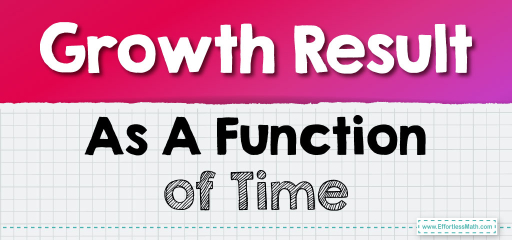Growth Result As A Function of Time
Simple growth and decay involve equations modeling the increase or decrease of quantities. These equations use a constant multiplier applied to the current value. Growth is described by positive constants, while decay involves negative constants. Examples include population growth and radioactive decay. These models help understand changes in various systems over time.

What is a growth and decay model?
Simple growth and decay are mathematical models used to describe how quantities change over time. Growth equations involve a constant multiplier that increases the current value, while decay equations use a constant that decreases it. For instance, population growth often exhibits exponential behavior, where the rate of change is proportional to the current population size. On the other hand, radioactive decay involves quantities decreasing over time. These models find applications in various fields, from biology (population growth) to physics (radioactive decay) and even in everyday scenarios like carbonation loss in beverages.
Let’s take a look at some examples and their differential equations:
- Newton’s Law of Cooling states that the rate of change of the temperature of an object is proportional to the difference between its own temperature and the ambient temperature.
- \(\frac{dT}{dt} = -k(T – T_{\text{env}})\),
- where \(T\) is the temperature of the object, \(T_{\text{env}}\) is the ambient temperature, and \(k\) is a positive constant.
- \(\frac{dT}{dt} = -k(T – T_{\text{env}})\),
- For a first-order chemical reaction, the rate of reaction is proportional to the concentration of a reactant.
- \(\frac{d[A]}{dt} = -k[A]\),
- where \([A]\) is the concentration of the reactant and \(k\) is the rate constant.
- \(\frac{d[A]}{dt} = -k[A]\),
- The growth of an investment with compound interest can be modeled by a differential equation.
- \(\frac{dP}{dt} = rP\),
- where \(P\) is the principal amount and \(r\) is the interest rate.
- \(\frac{dP}{dt} = rP\),
- The voltage across a capacitor in an RC circuit as it charges follows the equation:
- \(\frac{dV}{dt} = \frac{1}{RC}(V_{\text{source}} – V)\),
- where \(V\) is the voltage across the capacitor, \(V_{\text{source}}\) is the source voltage, \(R\) is the resistance, and \(C\) is the capacitance.
- \(\frac{dV}{dt} = \frac{1}{RC}(V_{\text{source}} – V)\),
- For an isothermal process in a gas, the pressure change can be modeled as:
- \(\frac{dP}{dV} = -\frac{nRT}{V^2}\),
- where \(P\) is the pressure, \(V\) is the volume, \(n\) is the amount of gas, \(R\) is the gas constant, and \(T\) is the temperature.
- \(\frac{dP}{dV} = -\frac{nRT}{V^2}\),
Related to This Article
More math articles
- Decoding Magnitudes: A Deep Dive into the Intricacies of Absolute Value Properties
- How to Ace the PSAT Math Test?
- How to Find Limits at Infinity
- Top 10 Tips You MUST Know to Retake the AFOQT Math
- 5th Grade TNReady Math Worksheets: FREE & Printable
- How to Convert a Linear Equation in Standard Form to Slope-Intercept Form?
- How to Find Least Common Multiple? (+FREE Worksheet!)
- What Skills Do I Need for the ALEKS Math Test?
- Subtraction of Four-Digit Numbers
- Top 10 Tips to Overcome PSAT Math Anxiety























What people say about "Growth Result As A Function of Time - Effortless Math: We Help Students Learn to LOVE Mathematics"?
No one replied yet.